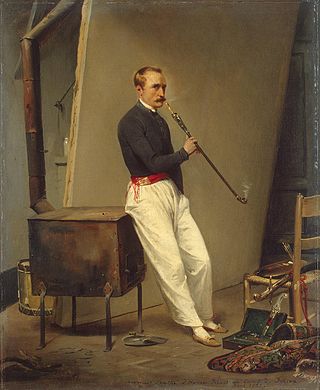
Émile Jean-Horace Vernet more commonly known as simply Horace Vernet, was a French painter of battles, portraits, and Orientalist subjects.

The Barrière de Clichy. Defence of Paris, 30 March 1814 is an oil-on-canvas painting by Horace Vernet from 1820. It shows a battle against Russian cossacks at the barrière de Clichy, highlighting the soldiers present but not engaged in fighting. Vernet's participation in this battle marked his only experience in active combat, which influenced his choice of subject matter for the remainder of his career.
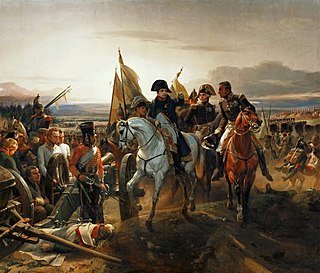
The Battle of Friedland is an 1835 history painting by the French artist Horace Vernet. It depicts the Battle of Friedland fought on 14 June 1807 in East Prussia during the Napoleonic Wars. The battle was a decisive victory for French forces over their Russian enemies. At the subsequent Treaty of Tilsit, Napoleon was able to dictate peace terms to his beaten opponents. It is also sometimes known as Napoleon at the Battle of Friedland.

Joseph Vernet Tied to a Mast During a Storm is an 1822 history painting by the French artist Horace Vernet. It depicts a famous, possibly apocryphal, incident from the life of the artist's grandfather the marine painter Joseph Vernet who lashed himself to the mast of a ship in order to witness the effects of a storm. He had received a commission from Louis XV to paint a series of pictures depicting the ports of France and after departing Italy had run into a violent storm. As a rising artist Horace Vernet promoted his connection with his celebrated grandfather but quickly developed a reputation as a prolific and versatile painter in his own right.

The Salon of 1824 was an art exhibition held at the Louvre in Paris between 25 August 1824 and 15 January 1825. It took place during the Restoration Era that followed the downfall of Napoleon's French Empire. At the time one of Europe's premier art exhibitions, the Salon was held roughly biennaly during the period. It was the first to be held since Charles X succeeded to the throne earlier the same year.

The Battle of Valmy is an 1826 history painting by the French artist Horace Vernet. It depicts the Battle of Valmy, one of the earliest battles of the French Revolutionary Wars fought on 20 September 1792. The revolutionary French troops defeated an advance by a coalition of Foreign forces under the command of the Duke of Brunswick.

The Battle of Montmirail is an 1822 history painting by the French artist Horace Vernet. It depicts the 1814 Battle of Montmirail during the Napoleonic Wars. It was one of four battle scenes Vernet painted on a commission by the Duke of Orleans, a cousin of Louis XVIII and himself a future monarch of France. Vernet received a total of thirty eight thousand francs for the four works. It depicts the Battle Montmirail, one of the final victories of the French emperor Napoleon. Fought on 11 February 1814 during the Six Days' Campaign, Napoleon's success there ultimately didn't prevent the fall of Paris and his abdication two months later.

The Siege of Antwerp is an 1840 history painting by the French artist Horace Vernet.
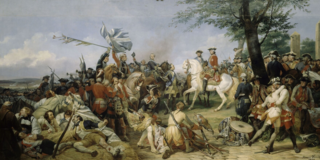
The Battle of Fontenoy is an 1828 history painting by the French artist Horace Vernet.

Portrait of Louise Vernet is a c.1830 portrait painting by the French artist Horace Vernet depicting his daughter Louise Vernet. While Vernet was known for his battle and history paintings, he also produced a number of portraits during his career.

Napoleon's Tomb is an 1821 oil painting by the French artist Horace Vernet. An allegory, it depicts the apotheosis of the former emperor of France Napoleon following his death in exile on the island of Saint Helena.

The Dog of the Regiment Wounded is a 1819 oil painting by the French artist Horace Vernet. It shows a battle scene from the Napoleonic Wars in which a dog, a regimental mascot, has been wounded in the fighting and is being treated by two French bandsman, a bugler of the voltigeurs and a drummer of the grenadiers.
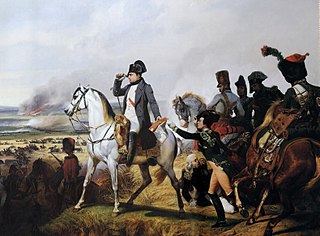
The Battle of Wagram is an 1836 history painting by the French artist Horace Vernet. It depicts Napoleon at the Battle of Wagram fought in July 1809 during the War of the Fifth Coalition. The battle, part of the Napoleonic Wars, was a victory for the French over the Austrian forces under Archduke Charles. Napoleon is mounted, watching the battle progress through a spyglass while he holds a half-opened battle plan in the other. Behind him Jean-Baptiste Bessières had had his horse shot from under him.

The Battle of Bouvines is an 1827 history painting by the French artist Horace Vernet. It depicts Philip II of France shortly before the Battle of Bouvines in 1214. A victory for Philip, the subsequent Truce of Chinon ended the Anglo-French War.
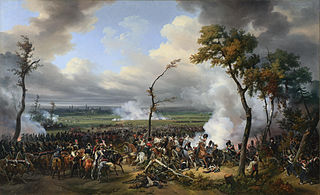
The Battle of Hanau is an 1824 history painting by the French artist Horace Vernet. It depicts the Battle of Hanau fought at Hanau in Hesse in October 1813 during the Napoleonic Wars.

Massacre of the Mamelukes is an 1819 history painting by the French artist Horace Vernet.

The Salon of 1819 was an art exhibition held at the Louvre in Paris between 25 August and 30 September 1819. It was the largest Salon to be staged since the fall of Napoleon. It took place during the Restoration era with Louis XVIII on the throne. It was the first to be held since the withdrawal of Allied Occupation forces from the country at the end of the previous year. The two officials behind the exhibition the Count Forbin and Vicomte de Senonnes set out to make it even more a celebration of the House of Bourbon that the previous Salon of 1817.

The Salon of 1831 was an art exhibition held at the Louvre in Paris between June and August 1831. It was the first Salon during the July Monarchy and the first to be held since the Salon of 1827, as a planned exhibition of 1830 was cancelled due to the French Revolution of 1830.

The Salon of 1822 was an art exhibition held at the Louvre in Paris, opening on 24 April 1822. The Salon took place every two or three years at the time and featured paintings and sculpture. One of the most notable works to be displayed was The Barque of Dante by the romantic painter Eugène Delacroix, which owed much to Théodore Géricault's The Raft of the Medusa which had appeared at the previous Salon of 1819. Taking place during the Restoration era, it was the last to be held during the reign of Louis XVIII. The Salon of 1824 took place after his brother Charles X had succeeded to the throne.

The Salon of 1814 was an art exhibition held at the Louvre in Paris from 5 November 1814. It was the first Salon to be held since the defeat of Napoleon and the Bourbon Restoration that brought Louis XVIII to the throne. It featured a mixture of paintings and works of sculpture.




















